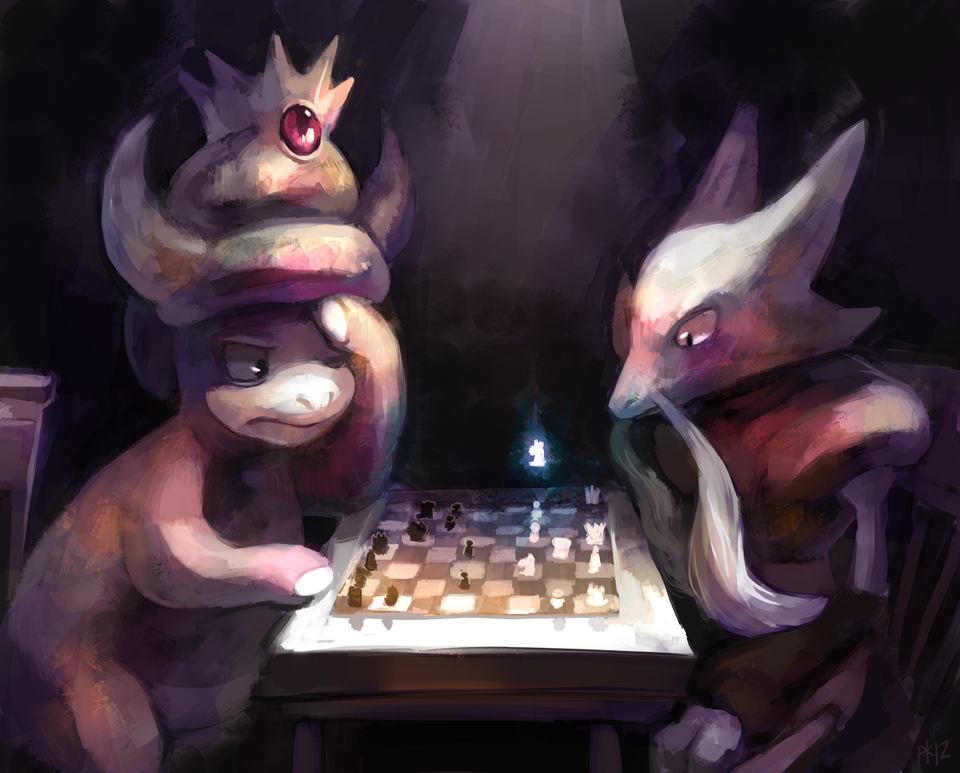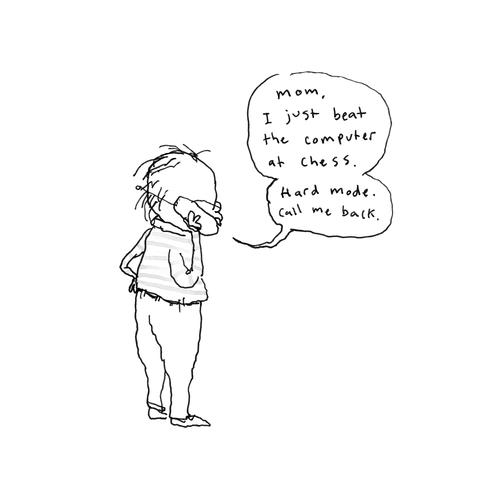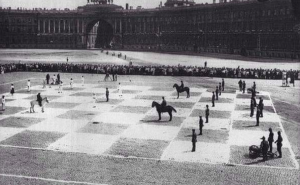


(from The Art of Pants)

Chess impersonations by Aman Hambleton | Trying to Lose by Aman Hambleton | Scachs d’Amor by Don Francí de Castellví, Narcís Vinyoles, and Mossèn Fenollar | A Brief History of Chess by Alex Gendler | Tani Adewumi: From homeless refugee to chess prodigy by Aishwarya Kumar | Chess Handshakes | Hikaru impersonation by Daniel Naroditsky | How to play chess properly | White Rabbit by Jefferson Airplane | White Queen by Queen | The March of the Black Queen by Queen | Hikaru walks up a staircase | Bobby Fischer, King of the Chess People by Drunk History | How chess plays out at MIT | Typical sub 500 rated chess (Baka Mitai) | Old Bobby Fischer | Funniest Evans Gambit Game Ever Played? by agadmator | The Secret to Chess? by Nate Solon | The société internationale d’UR
“The ability to play chess is the sign of a gentleman. The ability to play chess well is the sign of a wasted life.”
(Paul Morphy)
“Chess doesn’t drive people mad, it keeps mad people sane.”
(Bill Hartson)
“On Wednesday, World Chess champion Garry Kasparov tied Deep Blue, the IBM supercomputer that can examine 200 million positions per second, in the fourth game of their six-game series. Earlier in the week, Kasparov admitted he made a “catastrophic blunder” in game two when he failed to force a draw by moving rook to e8, opting instead for a Caro-Kann defense that soon transposed into a Pribyl defense, which after Deep Blue moved bishop to e7, gave it the advantage with its ninth position. With all due respect to Mr. Kasparov… what the hell were you thinking?”
(Norm Macdonald)
“In a life of pursuits adopted and discarded with the ebb and flow of Shannon’s promiscuous curiosity, chess remained one of his few lifelong pastimes. One story has it that Shannon played so much chess at Bell Labs that ‘at least one supervisor became somewhat worried.’ He had a gift for the game, and as word of his talent spread through-out the Labs, many would try their hand at beating him. ‘Most of us didn’t play more than once against him,’ recalled Brockway McMillan.
On a trip to Russia in 1965, Shannon offered a friendly game to Soviet international grandmaster and three-time world champion Mikhail Botvinnik. Botvinnik, having presumably endured countless games of show for various dignitaries, agreed to the match but played without paying much attention and nursed a cigarette throughout, his uninterest apparent to all in the room. Then, suddenly, Shannon managed to win the favorable exchange of his knight and a pawn for Botvinnik’s rook early in the contest. Botvinnik’s attention was instantly yanked back to the board, and the atmosphere of the room shifted as the Russian champion realized that his challenger was more than just another hapless dignitary. ‘Botvinnik was worried,’ Betty would remember years later.
The game went on far longer than anyone, including the surprised champion, could have predicted. But there was still no real doubt about the outcome. After forty-two moves, Shannon tipped his king over, conceding the match. Still, lasting dozens of moves against Botvinnik, considered among the most gifted chess players of all time, earned Shannon lifelong bragging rights.”
[…] Nearly a half century before Deep Blue defeated the world’s human champion, Shannon anticipated the value of chess as a sort of training ground for intelligent machines and their makers:
‘The chess machine is an ideal one to start with, since: (1) the problem is sharply defined both in allowed operations (the moves) and in the ultimate goal (checkmate); (2) it is neither so simple as to be trivial nor too difficult for satisfactory solution; (3) chess is generally considered to require ‘thinking’ for skillful play; a solution of this problem will force us either to admit the possibility of a mechanized thinking or to further restrict our concept of ‘thinking’; (4) the discrete structure of chess fits well into the digital nature of modern computers.
Shannon believed that, at least within the realm of chess, the inanimate had certain intrinsic advantages. The obvious ones were processing speeds well beyond the human brain and an endless capacity for computation. Further, an artificial intelligence wouldn’t be susceptible to boredom or exhaustion; it could continue to drill into a chess position well after its human counterpart had lost concentration. Computers were, in Shannon’s view, blessed with ‘freedom from errors,’ their only mistakes ‘due to deficiencies of the program while human players are continually guilty of very simple and obvious blunders’…
But–and Shannon was emphatic about the ‘but’–‘these must be balanced against the flexibility, imagination and inductive and learning capacities of the human mind.’ The great downfall of a chess-playing machine, Shannon thought, was that it couldn’t learn on the fly, a capacity he believed was vital for victory at the elite levels. He cites Reuben Fine, an American chess master, on the misconceptions about top-ranked players and their approach to the game: ‘Very often people have the idea that masters foresee everything or nearly everything.. that everything is mathematically calculated down to the smirk when the Queen’s Rook Pawn queens one move ahead of the opponent’s King’s Knight’s Pawn. All this is, of course, pure fantasy. The best course to follow is to note the major consequences for two moves, but try to work out forced variations as they go.’
In mastering the probabilities of each conceivable position, then, a chess computer would not simply be acting as a superpowered grand-master, but as a fundamentally different kind of player. Essentially, human and computer would be playing two different games while seated across the same board.”
(from A Mind at Play by Jimmy Soni and Rob Goodman)
“The principles of computer chess have not changed much since Shannon elaborated them 35 years ago. The problem is to choose the correct move from the given position, that is, the move that results in the best chance of winning. This is done by hypothesizing each legal move in turn and determining its consequences by evaluating the resulting position. The best move is the one that results in the best position. This analysis is much too primitive since it dos not consider the opponent’s possible responses. The answer is to determine the opponent’s best response to each of the player’s moves by applying the same procedure, except that the opponent’s best move is the one which results in the worst position for the first player. Extending this even further gives rise to a recursive minimax search that examines the tree formed by examining all moves and responses starting from the root position.”
[…] “There is a complex relationship between the evaluation function and the depth of search. As the search is able to see deeper, the evaluation function needs to know less about tactical factors other than simple material. For example, a capture is discovered by one ply search which knows only about material, the concept of a fork is discovered by a three ply search, and the threat of a fork by a five ply search. Thus the evaluation function used by an eight ply search has less need to know explicitly about a fork than a six ply search. It has also been observed that pins, which are tactical in nature, become less of a problem when searching to eight ply than to six ply where the evaluation function must be aware of them. In fact, Hitech does not understand the concept of pins but dos not appear to suffer greatly from this fact. It may be that at advanced levels of play this will become a deficiency which must be overcome either by a deeper search or by explicit knowledge.
Other positional factors that have widely been thought to be important appear to be less important when searching deeply. Board control and piece mobility, two closely related positional factors, were mentioned in Shannon’s original essay on computer chess. While it is true that these are important concepts, a deep search often sees far enough ahead to discover the implications of good or bad board control and mobility. Here again, Hitech has no direct measure of board control or mobility and yet rarely allows these to become a problem with its positional play. The key to building an effective evaluation function is deciding which factors are indeed important relative to the power of the search.”
[…] “Strategy refers to long term goals that guide one’s play. For example in the opening, one strategy may be to mount a king-side attack or to build an attack around a weakness in the opponent’s defense, while an endgame strategy would be to try to queen a certain pawn. A deep search will often see far enough ahead to make plans of its own; strategy refers to plans that are so long range that the search cannot find them. Strategy can often be achieved through incremental evaluation. For example, the oracle in its analysis may discover a weakness that it wishes to exploit or an angle of attack that it wishes to pursue. It can implement these plans by increasing the value of pieces on squares that further its plan. For example, it can pursue a king-side attack by increasing the value of its pieces on those squares that attack the squares in the vicinity of the king. Such a strategy is used in the assumption hat increasing pressure on the opponent’s king will create an opportunity that the deep search can exploit. A first-order evaluation works in this case since the king is not likely to move far within the search. Later in the game, when fewer pieces are blocking the path of the king and the search is deeper, a second-order evaluation may be necessary to relate he attacking pieces to the location of the king.
A typical strategy in the endgame involves queening pawns with the help of minor pieces and the king. In spire of their deep searching capabilities, computer often have not idea of how to proceed in such situations because long range plans are required. However, exact plans are not required, just some goal that leads the program to the place where it can see far enough ahead to formulate plans of its own. Typical plans involve knowing where the king should go to support its pawns or how to position rooks to give maximum support to their own pawns or to prevent the opponent’s pawns from queening. Since pawns do not move very far within the search and the oracle knows which way they’re going, a first-order evaluation can be used to indicate the ‘best’ squares for its pieces.
… We have been able to free the search from the tradeoff between speed and knowledge by using a generalized form of the distributed state architecture already used for move generation to do second-order evaluation almost as fast as first-order evaluation. Position evaluation is different from move generation because it is open-ended. While the moves that the move generator must recognize never change, it is not clear what knowledge should be included in position evaluation and how it should be used. As experience uncovers deficiencies, the evaluation must be improved to make it understand what it previously did not. This means that, unlike the move generator, the evaluation hardware should be programmable. This also makes the use of hardware more efficient, since the oracle can decide at each point in the game which evaluation components should be included, using the hardware for different evaluations as the game progresses. To otherwise perform all the evaluation that might be needed would require an order of magnitude more hardware. Thus the oracle has a similar role in second-order evaluation as in first-order evaluation, that of tuning the evaluation to the region of the search.
The depth of search has a great effect on the types of evaluation that are required. Many adages in chess serve to warn a player of the consequences of certain positional factors. A deep search can often discover these from first principles by looking at the consequences several moves ahead. In some sense, the deep search replaces the reasoning behind some of the more complex evaluation.
… That this evaluation architecture is effective is evidenced by the play of Hitech, a chess program that runs on special-purpose hardware based on this architecture. The combination of search speed and complex evaluation enabled by this architecture has carried its performance past that of any previous program. The power of this evaluation hardware lies in its ability to perform any number of second-order evaluations in parallel, with the results combined in O(log) time.”
(from All the Right Moves: A VLSI Architecture for Chess by Carl Ebeling)
